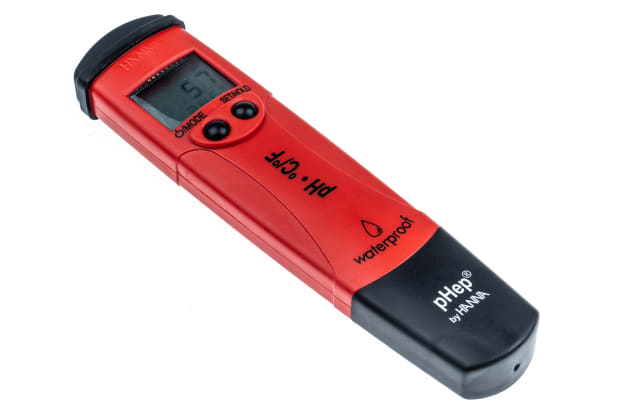- Published 15 Nov 2022
- Last Modified 29 Aug 2023
- 6 min
A Complete Guide to pH Meters
Our pH meter guide will help you understand what they’re used for, the different types, how they work, and how to use them.

pH is a logarithmic scale used to measure the acidity and alkalinity of solutions in applications as diverse as laboratories, aquariums, and manufacturing. From material preparation to testing and calibration, ensuring a precise pH level reading is essential. Fortunately, pH meters are designed for this exact purpose.
What is a pH Meter?
pH meters are useful instruments designed to accurately test and indicate pH levels. This is achieved by measuring the acidity and alkalinity of a solution, expressing it as pH.
The term ‘pH’ is signified by two symbols. The ‘p’ represents potential, whereas ‘H’ is the chemical symbol for the element hydrogen.
At a basic level, these instruments essentially consist of a pH-responsive electrode and an unvarying reference electrode, attached to a voltmeter. They may also be known as potentiometric pH meters.
What Does a pH Meter Measure?
pH meters measure the hydrogen-ion level in water-based solutions. The pH value (acidity or alkalinity) of a solution is determined by the ratio of hydrogen-ion and hydroxyl-ion concentration.
Applications of pH Meters
pH meters can be used in a wide range of applications and environments. They are versatile instruments ideal for measuring many different types of solutions and are also suitable for use in harsh environments and biological micro-environments.
Some common applications include:
- pH meters for water: from mains water supplies to swimming pools, testing the pH levels of water is one of the main uses of these instruments
- pH meters for food: the uses of pH meters in the food industry range from quality control to ensuring optimum pH levels in the brewing industry
- Soil pH meters: in agriculture, pH meters are used to test soil and determine nutrient availability and crop productivity
- Laboratory pH meters: pH meters are ideal for use in laboratories, assisting with experimental work and precision testing
- Aquarium pH meters: regular testing is important to ensure the pH levels of aquarium water stay within the correct range for the aquatic plants and animals within the aquarium
Types of pH Meters
pH Meter Accessories
Accessories for use with pH meters offer a wide range of additional benefits. They can provide improved functionality or ease of use in certain specific applications or environments. Alternatively, they can simply replace damaged or worn-out components of an existing pH meter.
Some models may also offer built-in or compatible printers. These enable straightforward computer interfacing and the option to print results and pH readings directly from the device, which can be handy for monitoring trends or conducting enhanced analysis.
How Does a pH Meter Work?

pH meters work by measuring the voltage between two electrodes – one is a reference electrode, and the other is pH-responsive. They essentially act like a battery when immersed in a solution.
The pH-responsive electrode develops an electric potential (charge) because of the hydrogen-ion activity in the solution. The potential difference between the two electrodes is then measured and converted into a pH value. This value is indicated to the user on the instrument’s display.
How to Use a pH Meter
Although this may vary for different applications, as a rule, the process for using a pH meter is as follows:
- Ensure the instrument has been calibrated before use if highly accurate measurements are required
- Place the electrode into the solution sample to be measured
- Press the measure button
- Leave the electrode in the solution for 1-2 minutes to ensure an accurate reading can take place
- Once the reading has stabilised, set the pH level
- Press the measure button again to get the pH level of the solution sample
- Remove the electrode from the solution and ensure it is clean and dry ready for the next use
How to Find the Most Accurate pH Meter?
Finding the best pH meter for a particular task can be tricky, and it often comes down to a question of accuracy. Recording precise pH levels is essential in many industries and applications, so it’s important to carefully select the most accurate pH meter to ensure your results are on-point.
However, the best pH meter will depend on several different factors that should be considered:
- Cost: typically, a more expensive instrument from a trusted manufacturer will record measurements to a higher degree of accuracy than cheaper alternatives
- Features: added functionality can be highly beneficial if you have a certain use case in mind for your pH meter
- Application: some meters are intended for a single specific application, whereas others are much more versatile and can be used across multiple applications
The most accurate pH meter will also depend on calibration. All pH meters need calibrating regularly to ensure they remain accurate, however, the frequency and standard of calibration will both affect the meter’s accuracy at any given time. If you need highly precise results, it is recommended to calibrate the instrument before taking the reading.


